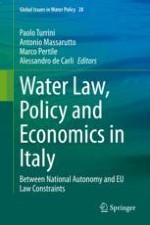2021 | OriginalPaper | Buchkapitel
3. The Uses and Value of Water in Italy: Evidence from Selected Case Studies in Italy, with a Particular Focus on Irrigation, Industry and Hydropower
verfasst von : Giulia Vaglietti, Federico Pontoni, Alessandro de Carli, Antonio Massarutto
Erschienen in: Water Law, Policy and Economics in Italy
Aktivieren Sie unsere intelligente Suche, um passende Fachinhalte oder Patente zu finden.
Wählen Sie Textabschnitte aus um mit Künstlicher Intelligenz passenden Patente zu finden. powered by
Markieren Sie Textabschnitte, um KI-gestützt weitere passende Inhalte zu finden. powered by
